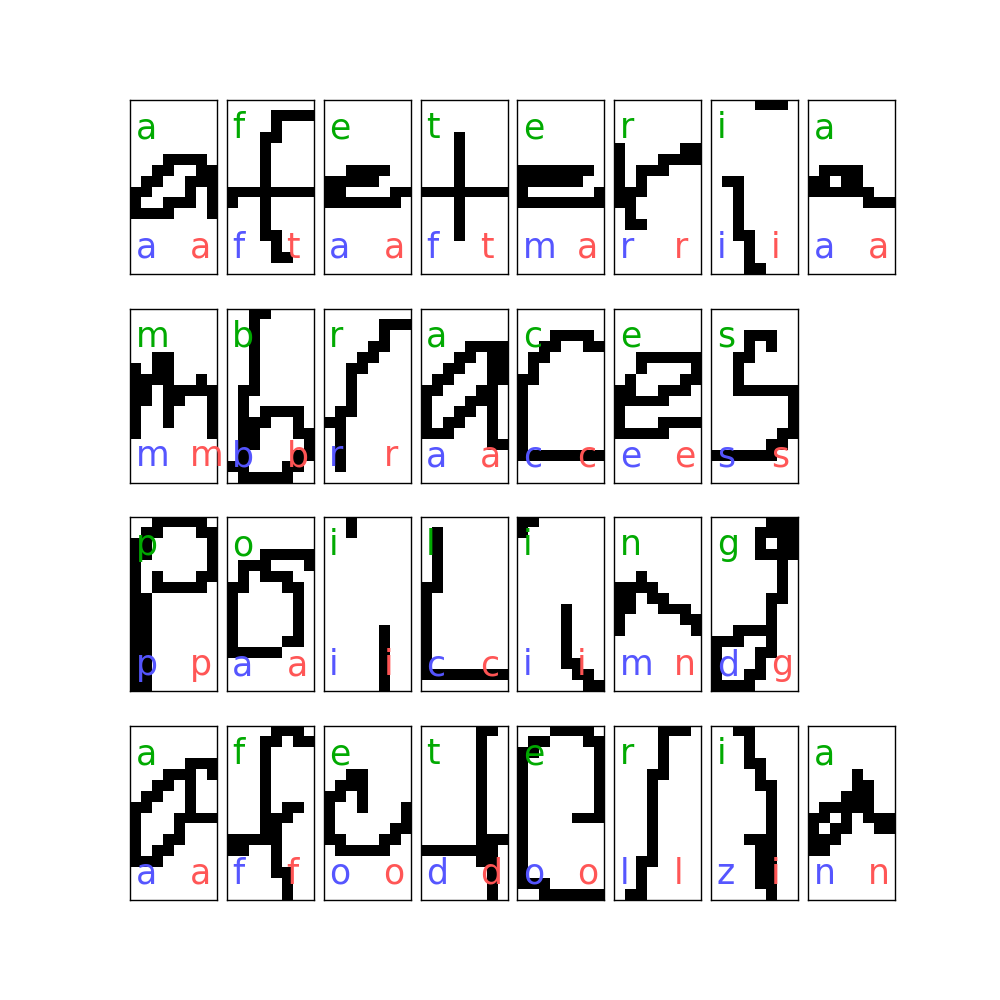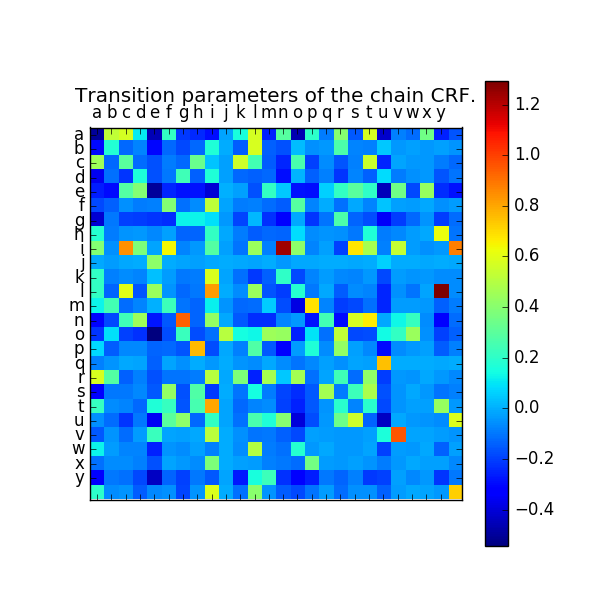OCR Letter sequence recognition¶
This example illustrates the use of a chain CRF for optical character recognition. The example is taken from Taskar et al “Max-margin markov random fields”.
Each example consists of a handwritten word, that was presegmented into characters. Each character is represented as a 16x8 binary image. The task is to classify the image into one of the 26 characters a-z. The first letter of every word was ommited as it was capitalized and the task does only consider small caps letters.
We compare classification using a standard linear SVM that classifies each letter individually with a chain CRF that can exploit correlations between neighboring letters (the correlation is particularly strong as the same words are used during training and testing).
The first figures shows the segmented letters of four words from the test set. In set are the ground truth (green), the prediction using SVM (blue) and the prediction using a chain CRF (red).
The second figure shows the pairwise potentials learned by the chain CRF. The strongest patterns are “y after l” and “n after i”.
There are obvious extensions that both methods could benefit from, such as window features or non-linear kernels. This example is more meant to give a demonstration of the CRF than to show its superiority.
Script output:
Test score with chain CRF: 0.787844
Test score with linear SVM: 0.713812
import numpy as np
import matplotlib.pyplot as plt
from sklearn.svm import LinearSVC
from pystruct.datasets import load_letters
from pystruct.models import ChainCRF
from pystruct.learners import FrankWolfeSSVM
abc = "abcdefghijklmnopqrstuvwxyz"
letters = load_letters()
X, y, folds = letters['data'], letters['labels'], letters['folds']
# we convert the lists to object arrays, as that makes slicing much more
# convenient
X, y = np.array(X), np.array(y)
X_train, X_test = X[folds == 1], X[folds != 1]
y_train, y_test = y[folds == 1], y[folds != 1]
# Train linear SVM
svm = LinearSVC(dual=False, C=.1)
# flatten input
svm.fit(np.vstack(X_train), np.hstack(y_train))
# Train linear chain CRF
model = ChainCRF()
ssvm = FrankWolfeSSVM(model=model, C=.1, max_iter=11)
ssvm.fit(X_train, y_train)
print("Test score with chain CRF: %f" % ssvm.score(X_test, y_test))
print("Test score with linear SVM: %f" % svm.score(np.vstack(X_test),
np.hstack(y_test)))
# plot some word sequenced
n_words = 4
rnd = np.random.RandomState(1)
selected = rnd.randint(len(y_test), size=n_words)
max_word_len = max([len(y_) for y_ in y_test[selected]])
fig, axes = plt.subplots(n_words, max_word_len, figsize=(10, 10))
fig.subplots_adjust(wspace=0)
for ind, axes_row in zip(selected, axes):
y_pred_svm = svm.predict(X_test[ind])
y_pred_chain = ssvm.predict([X_test[ind]])[0]
for i, (a, image, y_true, y_svm, y_chain) in enumerate(
zip(axes_row, X_test[ind], y_test[ind], y_pred_svm, y_pred_chain)):
a.matshow(image.reshape(16, 8), cmap=plt.cm.Greys)
a.text(0, 3, abc[y_true], color="#00AA00", size=25)
a.text(0, 14, abc[y_svm], color="#5555FF", size=25)
a.text(5, 14, abc[y_chain], color="#FF5555", size=25)
a.set_xticks(())
a.set_yticks(())
for ii in range(i + 1, max_word_len):
axes_row[ii].set_visible(False)
plt.matshow(ssvm.w[26 * 8 * 16:].reshape(26, 26))
plt.colorbar()
plt.title("Transition parameters of the chain CRF.")
plt.xticks(np.arange(25), abc)
plt.yticks(np.arange(25), abc)
plt.show()
Total running time of the script: (0 minutes 8.389 seconds)
Download Python source code: plot_letters.py

